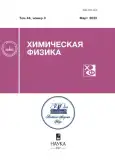Magnetic nanoparticles as a platform for delivery of the photosensitizer methylene blue to HCT116 tumor cells
- Autores: Nguyen M.T.1, Markova A.A.1, Batchaeva B.B.1, Gorobets M.G.1, Toroptseva A.V.1, Motyakin M.V.1, Abdullina M.I.1, Bychkova A.V.1
-
Afiliações:
- Emanuel Institute of Biochemical Physics, Russian Academy of Sciences
- Edição: Volume 44, Nº 3 (2025)
- Páginas: 106-110
- Seção: Chemical physics of nanomaterials
- URL: https://vietnamjournal.ru/0207-401X/article/view/679474
- DOI: https://doi.org/10.31857/S0207401X25030119
- ID: 679474
Citar
Texto integral
Resumo
Hybrid nanosystems based on magnetic iron oxide nanoparticles (IONPs) and human serum albumin (HSA), containing methylene blue (MB) as a model photosensitizer, have been synthesized. The resulting HSA@IONP nanosystems were characterized for size and composition using UV/visible spectrophotometry (particularly, using the Bradford method), dynamic light scattering, and electron magnetic resonance. A study of the dark and photoinduced cytotoxicity of MB, IONP, HSA@IONP, MB–IONP, MB–(HSA@IONP) on of human colon adenocarcinoma HCT116 cells was carried out. Under the experimental conditions, the difference between the dark and light-induced cytotoxicity of nanosystems on cells was significantly enhanced when the photosensitizer was immobilized on the surface of the carrier particles compared to free photosensitizer in equivalent concentrations.
Texto integral
Sobre autores
M. Nguyen
Emanuel Institute of Biochemical Physics, Russian Academy of Sciences
Email: anna.v.bychkova@gmail.com
Rússia, Moscow
A. Markova
Emanuel Institute of Biochemical Physics, Russian Academy of Sciences
Email: anna.v.bychkova@gmail.com
Rússia, Moscow
B. Batchaeva
Emanuel Institute of Biochemical Physics, Russian Academy of Sciences
Email: anna.v.bychkova@gmail.com
Rússia, Moscow
M. Gorobets
Emanuel Institute of Biochemical Physics, Russian Academy of Sciences
Email: anna.v.bychkova@gmail.com
Rússia, Moscow
A. Toroptseva
Emanuel Institute of Biochemical Physics, Russian Academy of Sciences
Email: anna.v.bychkova@gmail.com
Rússia, Moscow
M. Motyakin
Emanuel Institute of Biochemical Physics, Russian Academy of Sciences
Email: anna.v.bychkova@gmail.com
Rússia, Moscow
M. Abdullina
Emanuel Institute of Biochemical Physics, Russian Academy of Sciences
Email: anna.v.bychkova@gmail.com
Rússia, Moscow
A. Bychkova
Emanuel Institute of Biochemical Physics, Russian Academy of Sciences
Autor responsável pela correspondência
Email: anna.v.bychkova@gmail.com
Rússia, Moscow
Bibliografia
- Q. Chen, Z. Liu. Adv. Mater. 28, 10557–10566 (2016). https://doi.org/10.1002/adma.201600038
- L.L. Israel, A. Galstyan, E. Holler et al. J. Control. Release. 320, 45 (2020). https://doi.org/10.1016/j.jconrel.2020.01.009
- A.S. Chubarov. Magnetochemistry 8, 13 (18 pages) (2022). https://doi.org/10.3390/magnetochemistry8020013
- N.G. Berdnikova, A.E. Dontsov, M.V. Erokhina et al. Russ. J. Phys. Chem. B. 13, 942 (2019). https://doi.org/10.1134/S1990793119060150
- N.V. Menshutina, A.A. Uvarova, M.S. Mochalova et al. Russ. J. Phys. Chem. B. 17, № 7, 1507 (2023). https://doi.org/10.1134/S1990793123070163
- M.A. Kolyvanova, M.A. Klimovich, O.V. Dement’eva et al. Russ. J. Phys. Chem. B. 17, 206 (2023). https://doi.org/10.1134/S1990793123010062
- A.V. Povolotskiy, D.A. Soldatova, D.A. Lukyanov et al. Russ. J. Phys. Chem. B 17, 1398 (2023). https://doi.org/10.1134/S1990793123060192
- J.P. Tardivo, A. Del Giglio, C.S. de Oliveira et al. Photodiagnosis Photodyn. Ther. 2, 175 (2005). https://doi.org/10.1016/S1572-1000(05)00097-9
- Y. Zhang, Z. Ye, R. He et al. Colloids Surfaces B Biointerfaces 224, 113201 (2023). https://doi.org/10.1016/j.colsurfb.2023.113201
- V.H. Toledo, T.M. Yoshimura, S.T. Pereira et al. J. Photochem. Photobiol. B Biol. 209, 111956 (2020). https://doi.org/10.1016/j.jphotobiol.2020.111956
- J.A. Rodrigues, J.H. Correia. Int. J. Mol. Sci. 24, 12204 (2023). https://doi.org/10.3390/ijms241512204
- I.D. Burtsev, A.E. Egorov, A.A. Kostyukov et al. Russ. J. Phys. Chem. B. 16, 109 (2022). https://doi.org/10.1134/S1990793122010195
- M.A. Klimovich, N.N Sazhina, A.S. Radchenko et al. Russ. J. Phys. Chem. B. 15, 93 (2021). https://doi.org/10.1134/S1990793121010206
- A.V. Bychkova, M.N. Yakunina, M.V. Lopukhova et al. Pharmaceutics. 14, 2771 (2022). https://doi.org/10.3390/pharmaceutics14122771
- M.T. Nguyen, E.V. Guseva, A.N. Ataeva et al. Int. J. Mol. Sci. 24, 7995 (2023). https://doi.org/10.3390/ijms24097995
- F.I. Dalidchik, O.A. Lopatina, S.A. Kovalevsky et al. Russ. J. Phys. Chem. B. 18, 266 (2024). https://doi.org/10.1134/S1990793124010238
- Y.-J.Hu, W. Li, Y. Liu et al. J. Pharm. Biomed. Anal. 39, 740 (2005). https://doi.org/10.1016/j.jpba.2005.04.009
Arquivos suplementares











